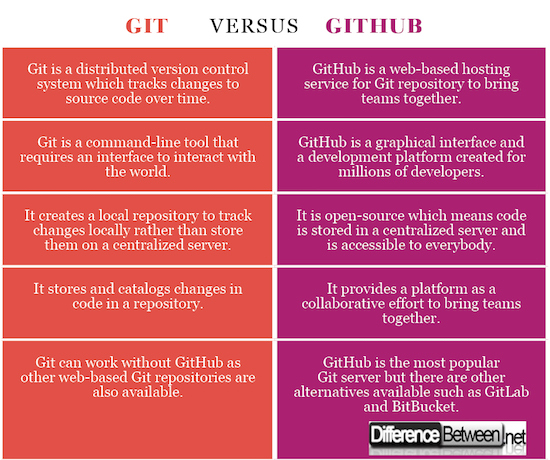Difference Between Git and GitHub
There are many software available that are used to handle management of changes to computer files including documents and programs, or mainly source codes to make sure the system runs smoothly and efficiently.
This system which keeps tabs on the changes to a file or multiple files is called “version control”. Without a proper version control system developing software becomes quite risky. It is simply a component of software configuration management that helps you track changes you make in your source code over time.
Git is the most widely used version control system out there which manages and stores the changes you made to code in a Git repository, whereas GitHub is an online hosting service for Git repositories.

What is Git?
Git is an open-source distributed version control system which allows you to manage the many variants of your project you’re working on by tracking the history of the changes made, while allowing for parallel versions at the same time.
Unlike a centralized version control system which uses a centralized storage location to catalog all files, Git uses a distributed system to store all the versions of a project file. It allows each user to maintain a local repository of his own which is nothing but the clone of the central repository. It allows them to make changes to their local repositories with updated data thereby integrating you changes into the main repository by a simple operation called “pull”.
All the changes are done locally without even interfering with the data on the main repository. If you wish to send your recent commit history from your local repository to the main repository, it can be done by an operation called “push”. Pushing simply sends your changes to the main repository such as GitHub so that it can be shared with the rest of the world.

What is GitHub?
Git is just a tool which needs an interface to interact with the web world. The most popular web-based Git interface is GitHub. Other web-based Git repositories include Savannah, GitLab, BitBucket, and SourceForge. GitHub offers all the functionalities of distributed revision control and source code management (SCM) along with its own features to create a platform that brings teams together under one roof to sort through problems as a team.
It simply brings all the benefits of a distributed version control system to a centralized service. It encourages you to manage development projects and build software alongside millions of other developers as a team. It’s a collaborative approach to create the world’s largest community of developers. Businesses of all sizes use the GitHub platform to host their work without worrying about administrative and security.
In simple terms, GitHub is a web-based graphical interface that hosts service for version control using Git.
Difference between Git and GitHub
Basic of Git and GitHub
Git is a distributed version control system designed to add access control and display the contents of a Git repository via the World Wide Web. Git is nothing but a tool which handles everything from small to large project projects by managing their source codes. GitHub, on the other hand, is an open-source platform where you can manage your projects and build software alongside other developers as a team. GitHub is a web-based hosting service for Git repositories.
Function of Git and GitHub
Git is a version control software that helps you keep track of your changes to the source code by compartmentalizing each change as a “version” rather than storing all the changes in a central server. GitHub, on the other hand, is a website that hosts Git repositories in a central server to share them with the rest of the world.
Access of Git and GitHub
Git is a source code versioning system that lets you track changes locally by creating a local repository which can be accessed only by the specific user, thereby allowing you to make changes to your local repository. The local repository is nothing but a clone of the central repository. GitHub is a free service which brings all the benefits of a distributed VCS to a centralized service. As it is open-source, almost everybody can access everybody else’s code.
Interface of Git and GitHub
Git is nothing but a command line tool without an interface and a centralized server to store your code. Instead, it lets you make your own local machine a local repository for your source code. GitHub, on the other hand, is a web-based graphical interface that brings millions of developers under one platform to collaborate on the projects they are working on.
Purpose of Git and GitHub
The purpose of Git is to manage a project as it witnesses changes over time and store the changes as “version” in a data structure called a repository, which monitors and catalogs those changes. GitHub is a web-based hosting service for Git repository and a developer’s platform for collaborative works.
Git vs. GitHub: Comparison Chart

Summary of Git and GitHub
Git is one of the most popular and widely used version control systems out there. It’s a distributed version control system designed to add access control and display the contents of a Git repository via the World Wide Web. It can handle everything from small to large scale projects much efficiently. GitHub is a web-based Git repository hosting service that creates a centralized storage space where users can store and access their web development projects.
- Difference Between Caucus and Primary - June 18, 2024
- Difference Between PPO and POS - May 30, 2024
- Difference Between RFID and NFC - May 28, 2024
Search DifferenceBetween.net :
2 Comments
Leave a Response
References :
[0]Chacon, Scott and Ben Straub. Pro Git (2nd ed.). NYC: Apress, 2014. Print
[1]Pipinellis, Achilleas. GitHub Essentials. Birmingham: Packt Publishing, 2015. Print
[2]Beer, Brent. Introducing GitHub: A Non-Technical Guide. Sebastopol: O’Reilly Media, 2018. Print
[3]Image credit: https://upload.wikimedia.org/wikipedia/commons/thumb/2/24/GitHub_logo_2013_padded.svg/2000px-GitHub_logo_2013_padded.svg.png
[4]Image credit: https://upload.wikimedia.org/wikipedia/commons/thumb/2/24/GitHub_logo_2013_padded.svg/2000px-GitHub_logo_2013_padded.svg.png
[5]Image credit: https://upload.wikimedia.org/wikipedia/commons/thumb/e/e0/Git-logo.svg/512px-Git-logo.svg.png

The most important thing is: Git is software; GitHub is a company!
Very Nice explanation. Liked it.